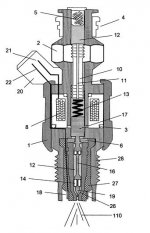boomdriver
Well-known member
Interesting...the spring. I have no idea what that is ! Could it be from the pintle of the injector? the pintle return spring? I know the Bosch injectors have a screen or basket in there at the top, but the Accel may be constructed different? Regardless, it looks like replacing injectors is justified (as is the expense) and you'll be pleased with the Bosch.
The oil film might be leakage from the PCV system. Those passages carbon up pretty bad, pretty quick but don;t really create a problem,. Just messy inside. From your photos your intake is not very dirty at all.
I've seen lots that had crud caked in the corners and crevices.
The oil film might be leakage from the PCV system. Those passages carbon up pretty bad, pretty quick but don;t really create a problem,. Just messy inside. From your photos your intake is not very dirty at all.

I've seen lots that had crud caked in the corners and crevices.









